Ground Control: A Journey Through Chess and Space showcases out-of-this-world artifacts from the collection of the World Chess Hall of Fame (WCHOF) and lenders Duncan Pohl and Allan Savage. Organized in connection with the 50th anniversary of the Apollo 11 moon landing on July 16,1969, Ground Control also examines important chess events from 1969 including Boris Spassky’s victory in the World Chess Championship, Nona Gaprindashvili’s win in the Women’s World Chess Championship, important tournaments in the United States and around the world as well as the births of future world chess champion Viswanathan Anand and trailblazer and future women’s world chess champion Susan Polgar.
Just as the 1972 world chess championship match between Bobby Fischer and Boris Spassky is often seen as an embodiment of the Cold War tensions between the United States and Soviet Union, in the space race, the two nations competed for superiority in the realms of science and technology. They sought to achieve important firsts in space exploration, such as putting the first satellite into orbit, the first manned space flights, and putting a person on the moon. Some of the artifacts in Ground Control testify to the excitement of these years—a chessboard featuring a Soviet rocket blasting into space and artifacts related to a game between the cosmonauts aboard Soyuz 9 (Andrian Nikolayev and Vitaly Sevastyanov) and cosmonaut Viktor Gorbatko and general Nikolai P. Kamanin, who were on Earth.
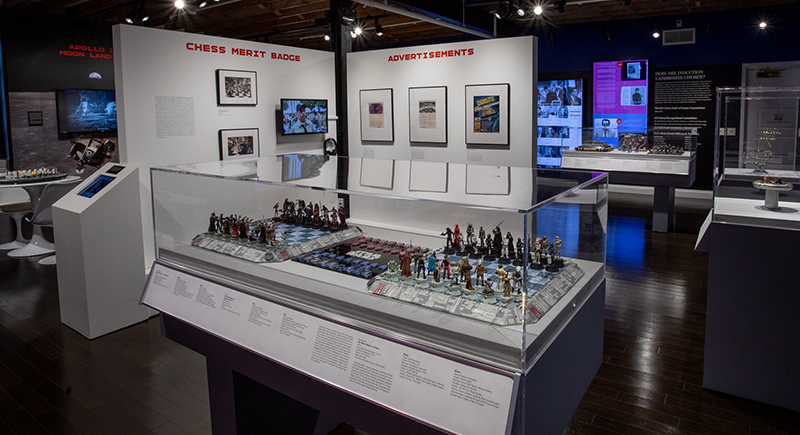
Ground Control Gallery View
Photo by Carmody Creative
Space also has a special connection to the history of the WCHOF. One highlight of our collection, acquired after the museum moved from Miami to Saint Louis, is the chessboard flown as part of the official flight kit on the last mission of the Space Shuttle Endeavour (May 16-June 1, 2011). Competitors in the 2010 U.S. and U.S. Women’s Chess Championships, which were held at the Saint Louis Chess Club, signed the board. Also, NASA astronaut Greg Chamitoff was present at the opening festivities of the World Chess Hall of Fame, which coincided with the launch of the Boy Scouts of America Chess Merit Badge (September 11, 2011). Dr. Jeanne Sinquefield led the effort to establish the chess merit badge. Scouts reenacted a recent game between space and Earth on a life-sized board before they received the very first badges.
Chess is one of the world’s oldest games, but it is often featured in visions of the future and the far reaches of the galaxy. Mr. Spock played Tri-Dimensional Chess against Captain James Kirk in Star Trek, which aired from September 8, 1966, through June 3, 1969. The game continued to appear in later Star Trek franchises. The WCHOF’s collection, which numbers over 1000, includes sets related to the game’s top players as well as ones with pop culture themes taken from television shows and movies set in space, including The Jetsons, Star Wars, and Star Trek. Many of these are included in Ground Control. We hope that you will enjoy this exhibition, whether you’re a space enthusiast, a pop culture junkie, or a fan of history.
Shannon Bailey, Chief Curator, World Chess Hall of Fame
Emily Allred, Associate Curator, World Chess Hall of Fame
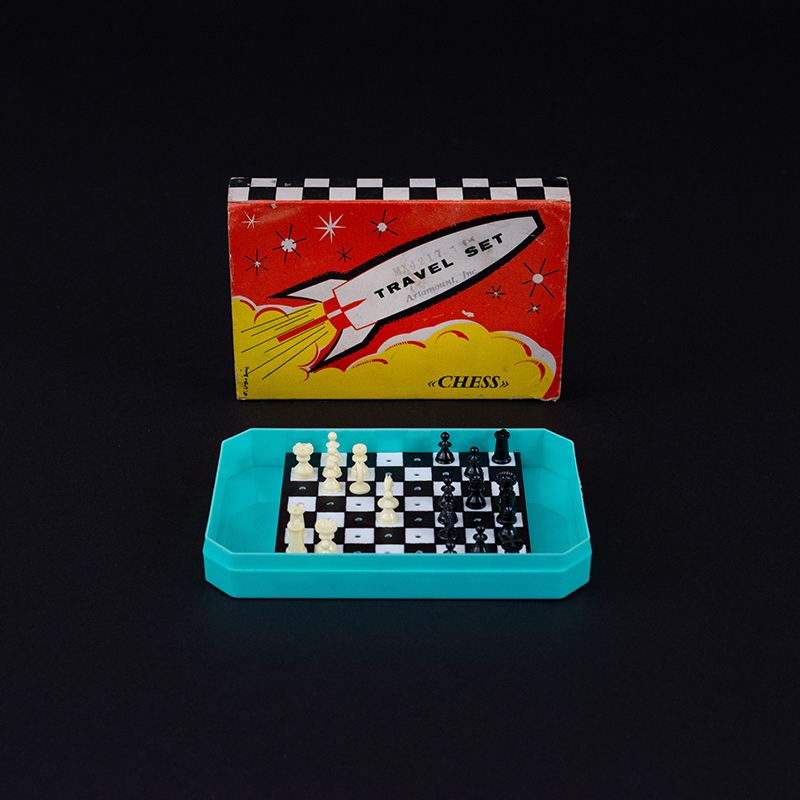
Artamount, Inc.
Jeu d’Échecs Pour le Voyage (Travel Chess Set)
c. mid-20th century
King size: ³⁄₄ in.
Board: 4 x 6 x 1 in.
Plastic and cardboard
Private Collection, Saint Louis, MO
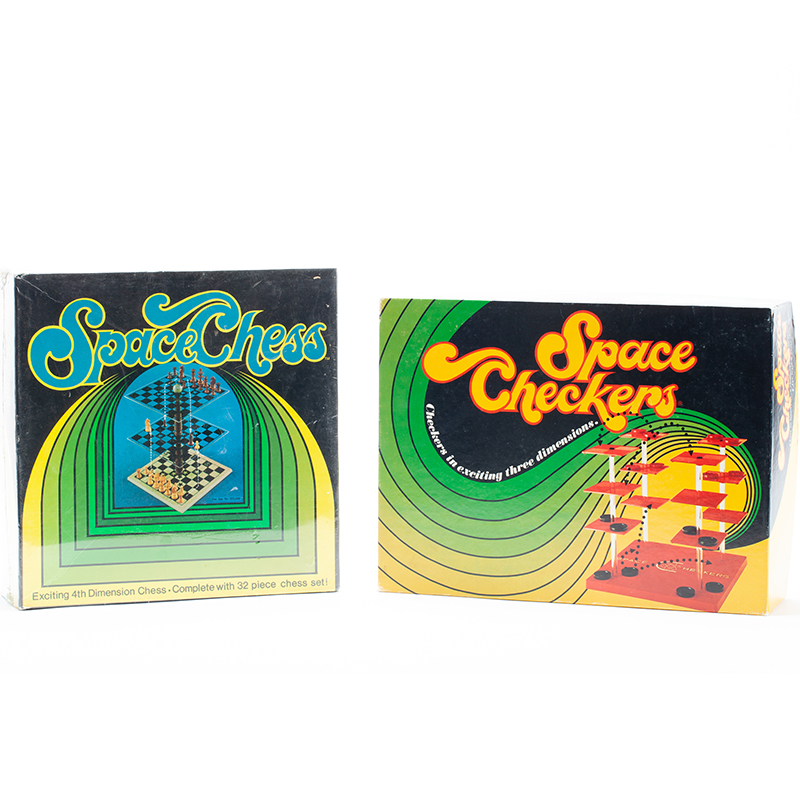
Pacific Game Company
Space Checkers
1971
9 ¹⁄₄ x 9 x 9 in.
Plastic
Collection of the World Chess Hall of Fame
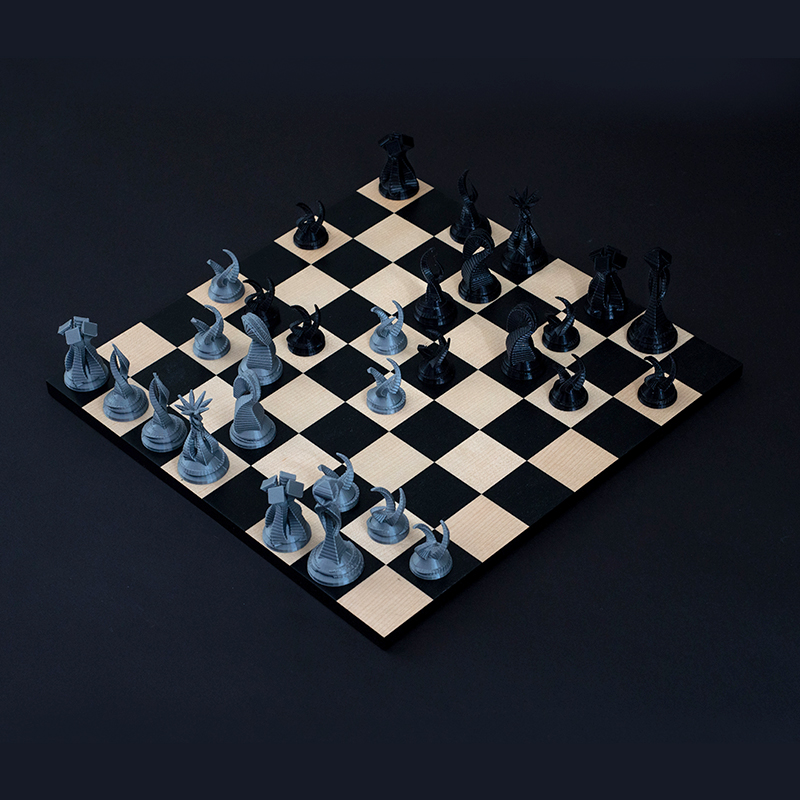
Ethan Jurman
Alien Life Chess Set
2019
King size: 3 ³⁄₁₆ in.
3-D printed plastic
Collection of the World Chess Hall of Fame
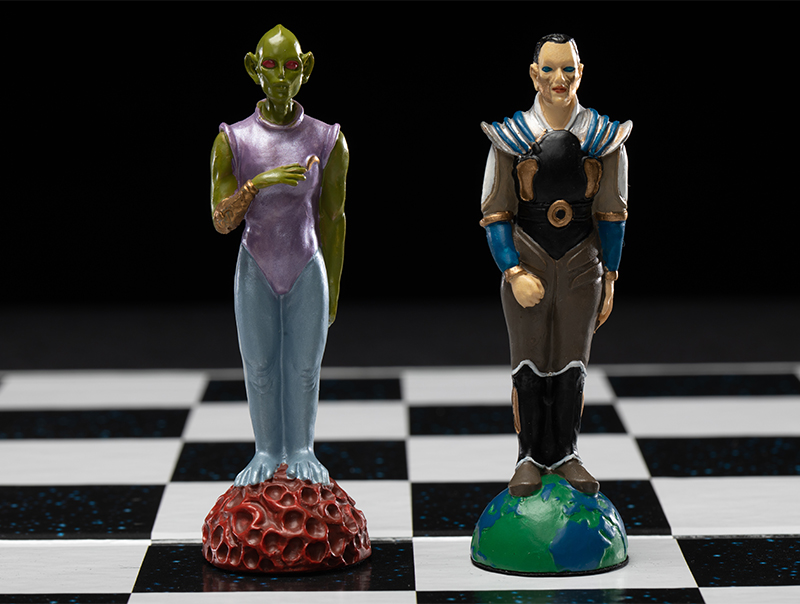
Summit Collection
Aliens vs. Humans Chess Set
Date unknown
King size: Commander Smith: 3 ³⁄₁₆ in.;
Jorel: 3 ⁵⁄₁₆ in.
Cold cast resin
Collection of the World Chess Hall of Fame
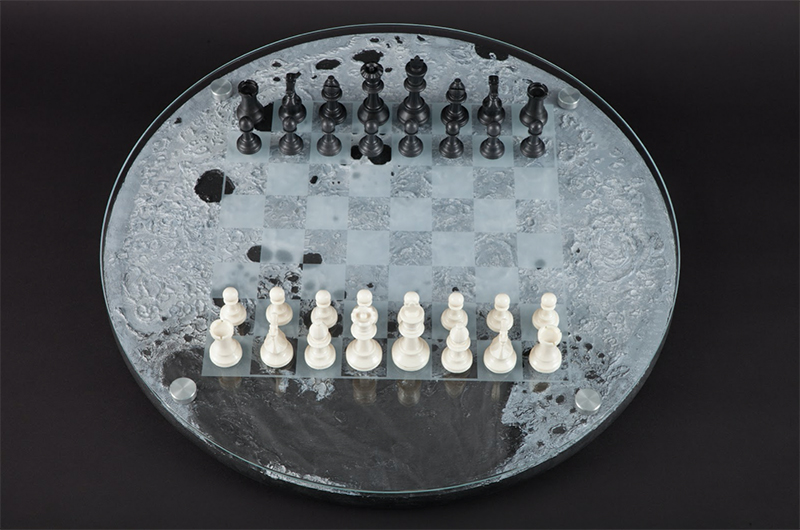
Michael DeFilippo
Play Chess On the Moon
2017
2 1⁄8 x 23 9⁄16 in. dia.
Etched glass, joint compound, latex paint, and wood
Collection of the World Chess Hall of Fame, gift of Michael DeFilippo
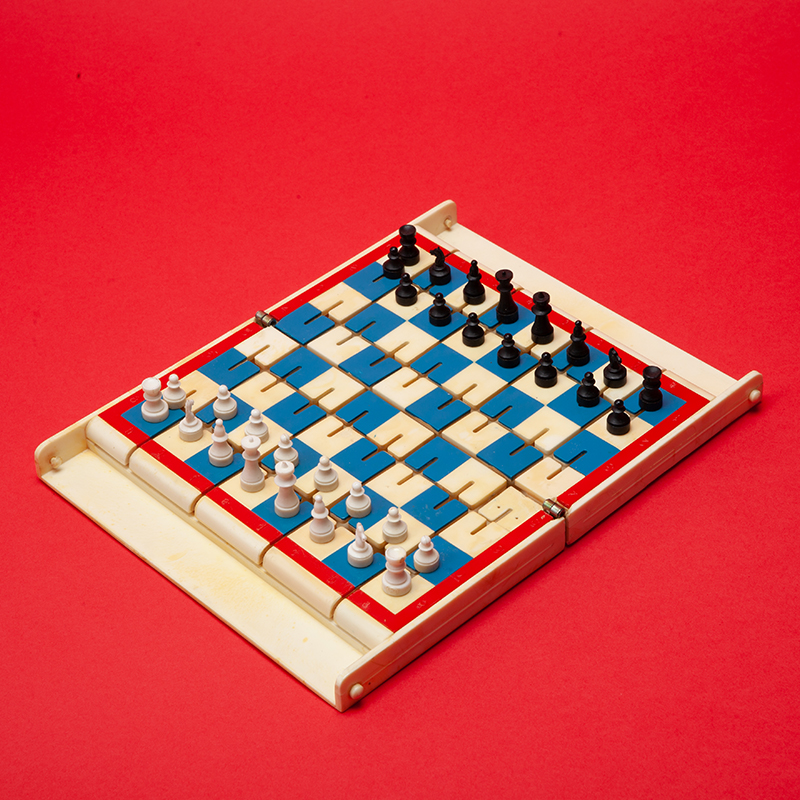
Mikhail I Klevtsov
Soyuz 9 — Soviet Zero-Gravity Chess Set
1970
King size: 1 1/16 in.
Board: 7 ¼ x 7 ¼ in.
Box: 5 ¼ x 7 ⅞ x 1 ⅝ in.
Plastic and paper
Collection of the World Chess Hall of Fame

Manufacturer unknown
Star Trek: The Next Generation
1999
King size: 3 ⅝ in.
Board 19 x 15 ¼ in.
Plastic and cardboard
Collection of the World Chess Hall of Fame
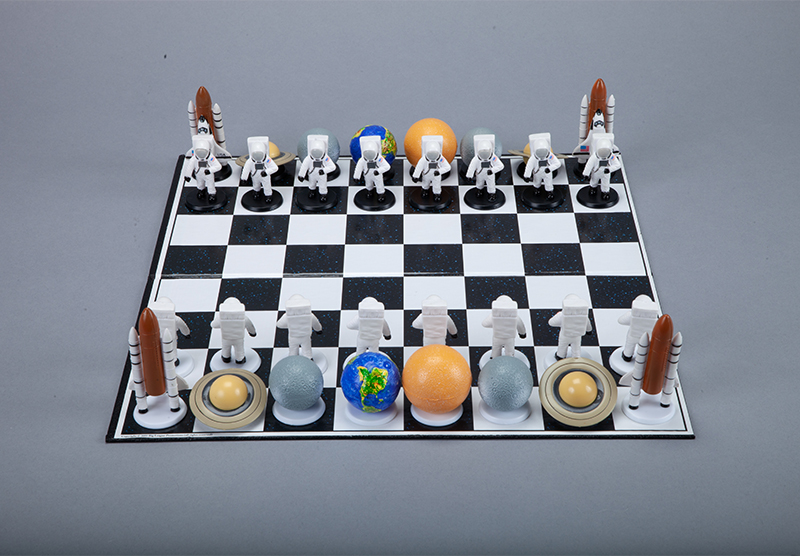
Rico Industries Inc.
Space Chess
Date unknown
King:1 ¾ in.
Board: 14 x 14 in.
Chess Set and Board
Collection of the World Chess Hall of Fame
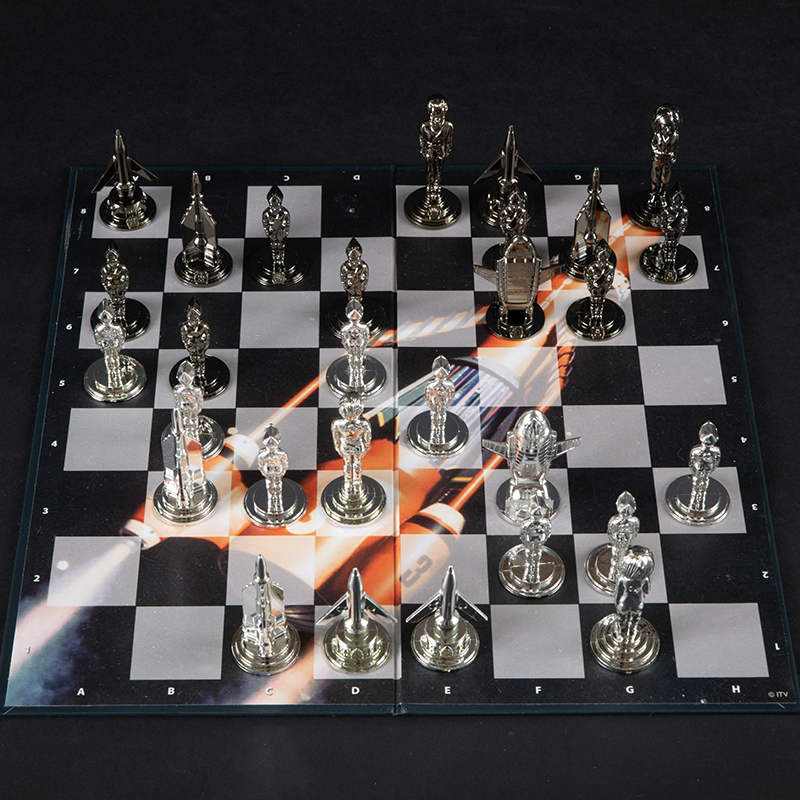
Tactic Games
Thunderbirds: 50 Years Chess Set
2015
King size: 2 ¹⁄₂ in.
Plastic
Collection of the World Chess Hall of Fame
Chess in 1969
1969 was an important year for chess. The Fischer Boom, with the 1972 World Championship match in Reykjavík providing front-page headlines each morning and leading the news each evening, was three years in the future, but signs were already present the chess world would soon experience significant changes.
Boris Spassky dethroned the world chess champion by a score of 12½-10½ in a match lasting over two months to become the tenth world champion. Petrosian would continue to play at a high level the rest of his career but would never again be a participant in a World Championship match. Like many of the best players (Mikhail Botvinnik, Vassily Smyslov, Mikhail Tal and Yefim Geller) of the 1950s and 1960s, Petrosian’s best days came to end in the late 1960s. Soon a generation of young stars would be replacing them at the top, the one exception being Viktor Korchnoi who only reached his peak in the late 1970s as he approached his 50th birthday.
The challenger was not as lucky in the 1969 Women’s World Championship match as Nona Gaprindashvili successfully defended her crown against Alla Kushnir by a score of 12-7. The two rivals would meet three times for the title between 1965 and 1972 with Nona winning on each occasion. The quality of play in these matches, on the level of an international master, was significantly higher than seen in previous Women’s World Championship competitions and would continue to rise in the 1970s, the result of more women playing and increased opportunities to meet stronger opponents in mixed competitions.
Spassky and Gaprindashvili were not the only Soviets to triumph in 1969. Eighteen-year-old Anatoly Karpov, from the Siberian city of Zlatoust, won the World Junior Championship in Stockholm. Karpov’s victory ended a long drought for the Soviets in the annual competition open to players under 21 as he became their first winner since 1955. Who could have predicted in 1969 that Karpov would go on to become one of the greatest players of all time?
In 1969 Women’s Olympiads were played on only two boards (with one reserve), and the Soviet Union dominated the competition. In the 1969 event held in Lublin, Poland, they scored 26 out of a possible 28 to finish well ahead of Hungary (201/2) and Czechoslovakia (19). Today the Open and Women’s competitions in the Olympiads have the same team composition—four players and one reserve—a reflection of not only how many more female players there are, but also how much stronger they play.
Berkeley Chess School founder Elizabeth Shaughnessy made her debut for the Irish team in the 1969 Olympiad and would go on to represent her homeland in another six Olympiads. Later, in her new hometown of Berkeley, California, she would build a program from scratch that would teach tens of thousands of kids to play chess, a harbinger of the scholastic boom of the 1990s, 2000s, and 2010s.
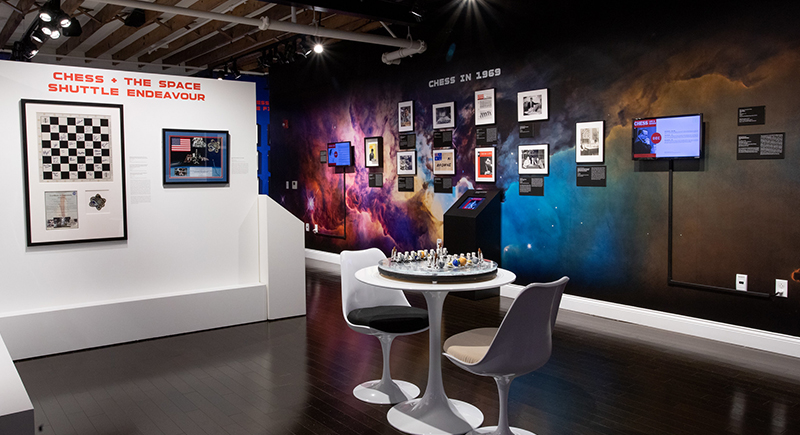
Ground Control Gallery View
Photo by Carmody Creative
Bobby Fischer played no tournament or match games in 1969, but his presence was still strongly felt. The publication of My Sixty Memorable Games in January was a commercial as well as critical success, and the hardcover and paperback editions would go through several reprintings. Even in the 21st century, this book is considered one of the greatest chess books ever written, both for its deep pre-computer analysis and Fischer’s frank comments. His 1972 match with Spassky would cause an explosion of interest in the game that would be noticed by English language publishers both in the United States and the United Kingdom. The result would be dozens and dozens of new chess books appearing in the mid-1970s with many of them published by the British firm Batsford and R.H.M. in the United States.
Fischer’s 1968 victories at Netanya and Vinkovci helped make him the top-rated player on the 1969 FIDE rating list at 2720, 30 points ahead of World Champion Boris Spassky and forty points in front of GM Viktor Korchnoi. GMs Bent Larsen of Denmark and Lajos Portisch of Hungary joined Fischer as the only non-Soviets among the top ten.
Right behind Korchnoi on the 1969 FIDE rating list was the “Patriarch of Soviet Chess,” 57-year-old World Chess Champion Mikhail Botvinnik. Rated number four in the world at 2660, he shared first place with GM Efim Geller at the annual Wijk aan Zee tournament with 10½/15, a half point ahead of GMs Portisch and Paul Keres.
It was very good year for Portisch, who won at Amster-dam with 11½/15, at Monte Carlo (tied with Smyslov) on 8/11 and at Hastings (the 1969/70 edition), scoring 6/9, ahead of Vlastimil Hort, Svetozar Gligoric, and Wolfgang Uhlmann.
The 1969 US Chess Championship was held at the end of the year in New York City. Fifty-eight-year-old GM Samuel Reshevsky won his eighth title with an 8-3 score followed by IM William Addison at 7½ and GM Pal Benko on 7. That year the U.S. Championship was a Zonal and all three won spots in the 1970 Interzonal. This proved significant when Benko ended up giving his place to Fischer, the beginning of the latter’s journey to becoming world champion. If Benko had not done this Bobby would have had to wait another three years for a shot at the crown. Before 1972, all American players outside of Fischer and Reshevsky were at best semi-professionals. This would soon change due to increased prize funds and more teaching and writing opportunities.
WIM Gisela Gresser set a record when she won her ninth U.S. Women’s Championship at the age of 63 with a score of 7½ from 9, a point ahead of her long-time rival WIM Mona May Karff. The closest any woman has come to Gresser in the last 50 years is GM Irina Krush with seven titles. Today most top female players learn to play well before they are 10, but Gresser didn’t pick up the game until she was in her late 30s! She only won her first U.S. Women’s Championship title in 1944 at the age of 38 and became a US Chess rated master in 1963 at 57—an age when players are long retired.
Contrast Gresser with GM Susan Polgar who hold the American records for highest rated female player (2577 FIDE) and (2598 USCF). Polgar was born on April 19, 1969, in Budapest, Hungary, and her parents started teaching the game not long after she could walk and talk. She later led the United States to its best-ever finish (second place) in the 2004 Women’s Chess Olympiad, turning in the best individual performance of the event. The former Women’s World Champion has led Texas Tech and Webster University to many collegiate titles.
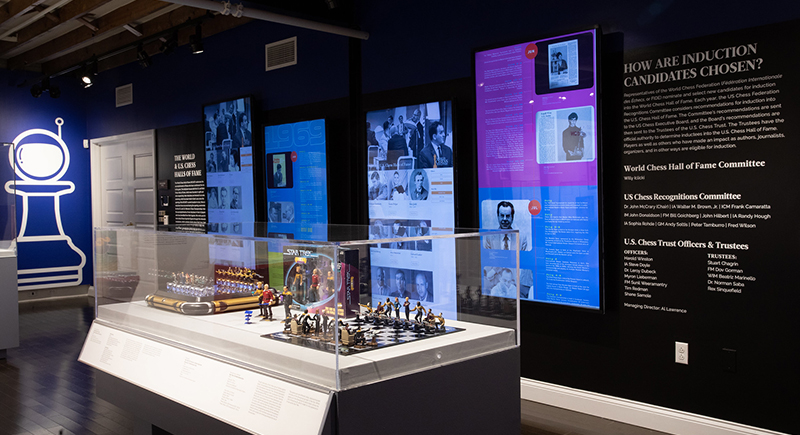
Ground Control Gallery View
Photo by Carmody Creative
Future U.S. Chess Hall of Famers Pal Benko, Milan Vukcevich, and Arthur Bisguier tied for first with scores of 9½-2½ in the 70th U.S. Open held August 10-22 in Lincoln, Nebraska. Seattle Master Viktors Pupols of Seattle was the early front runner after defeating Benko in round seven, but faded near the end to finish with 8½ points. Pupols, at the age of 85, has already played over 100 tournament games in 2019. This past February he defeated International Master Bryce Tiglon in the Washington State Championship, an event he first played in back in 1954! This example of an octogenarian playing successfully is not common, but hardly unknown as just this year 82-year International Master Anthony Saidy defeated a 2500+ FIDE rated grandmaster at the National Open.
During the U.S. Open in Lincoln, outgoing US Chess Federation President Marshall Rohland of Wisconsin reported the organization’s membership had increased from 11,202 to 13,488. This steady growth was typical for the US Chess Federation during the 1960s and set the table for the massive increase it experienced during the Fischer Boom—up to almost 60,000 members in 1973. This number rapidly decreased when Bobby failed to defend his title and the 1973 record total was not eclipsed until 1992. Today, thanks to a tremendous rise in the number of scholastic players, the organization is rapidly approaching 100,000 members.
The U.S. Chess Federation magazine Chess Life and U.S. Chess Hall of Famer Al Horowitz’s Chess Review (founded in 1933) merged in the fall of 1969 with the new publication adopting the name Chess Life & Review. This lasted until the early 1980s when it reverted back to Chess Life.
—IM John Donaldson
International Master John Donaldson served as Chess Director of the Mechanics’ Institute in San Francisco, California, from 1998 to 2018. He worked for Inside Chess magazine from 1988 to 2000 and has authored over 30 books on the game. Donaldson earned the IM title in 1983, has two norms toward the coveted GM title, and has captained the U.S. national chess team on 21 occasions, including to gold in the 2016 Baku Chess Olympiad—the first time for the U.S. since 1976.

Photographer unknown
Leonard Nimoy as Mr. Spock from Star Trek
1965
10 x 8 in.
Photograph
Collection of the World Chess Hall of Fame

Playmates
Star Trek 1701 Collector’s Edition Figurines featuring Tri-Dimensional Chess
1998
Captain Jean-Luc Picard: 5 ¹⁄₈ in.
Lt. Natasha Yar: 5 in.
Lt. Reginald Barclay: 5 in.
Box: 14 x 9 ¹⁄₈ x 2 ¹⁄₂ in.
Plastic
Collection of the World Chess Hall of Fame
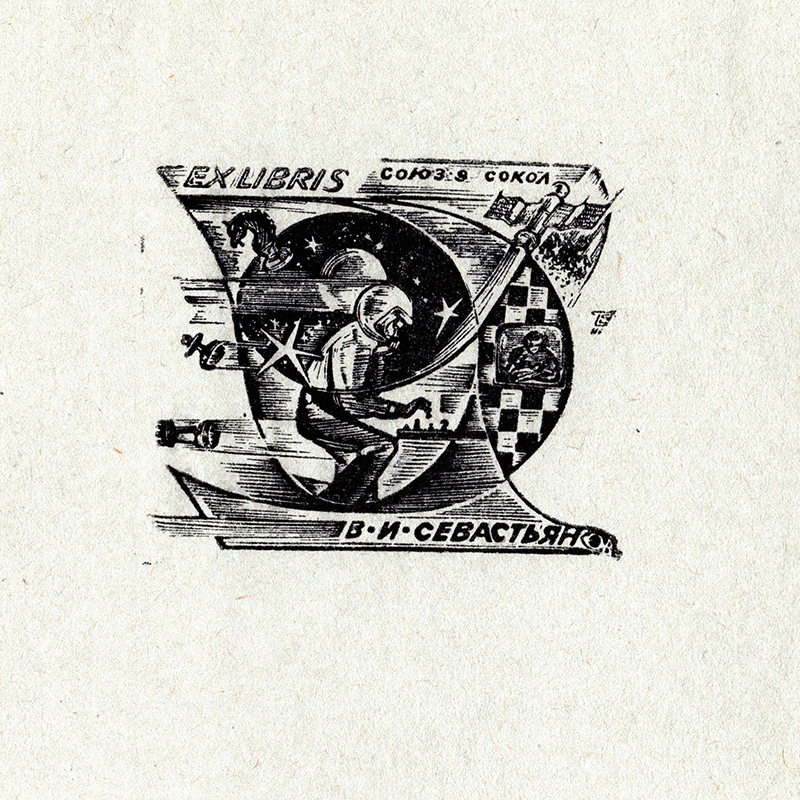
Terekhov
Ex-libris from the Library of Vitaly Sevastyanov
1970-1989
3 ⁷⁄₈ x 3 ⁷⁄₈ in.
Ink on paper
Collection of the World Chess Hall of Fame
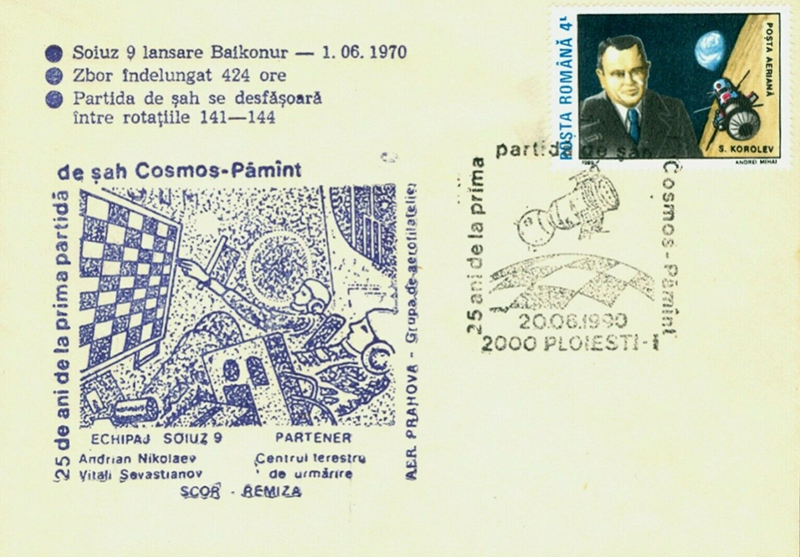
First Day Cover Honoring the 20th Anniversary
of the First Earth vs. Space Chess Game
1970
4 x 6 ¹⁄₄ in.
Paper
Collection of the World Chess Hall of Fame
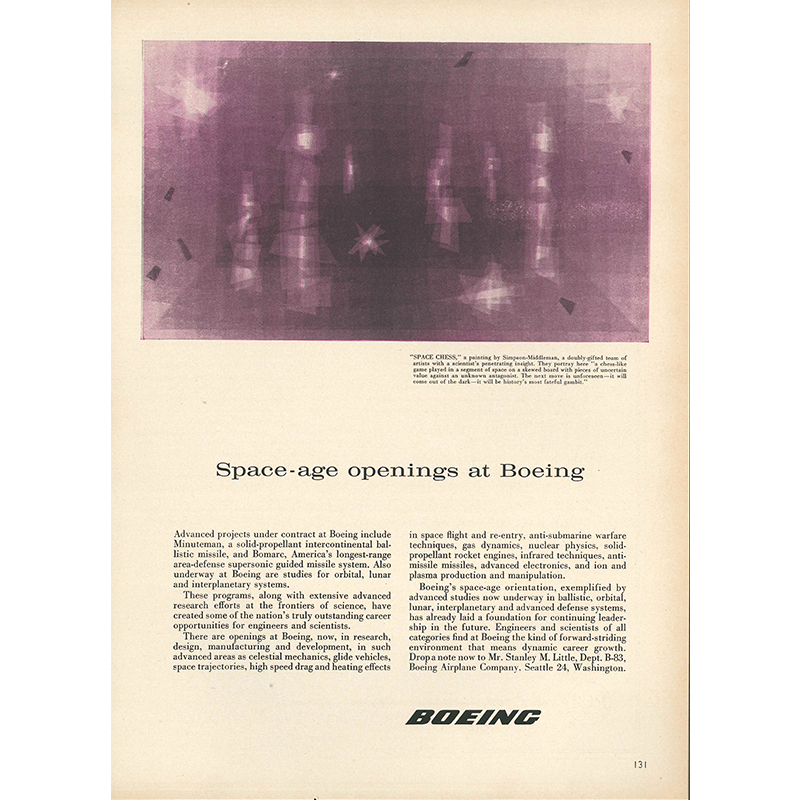
Boeing Advertisement
1959
11 ¹⁄₄ x 8 in.
Paper
Collection of the World Chess Hall of Fame

Star Trek: The Next Generation
Collector’s Chess Set Advertisement
1994
10 ¹³⁄₁₆ x 8 ¹⁄₈ in.
Paper
Collection of the World Chess Hall of Fame
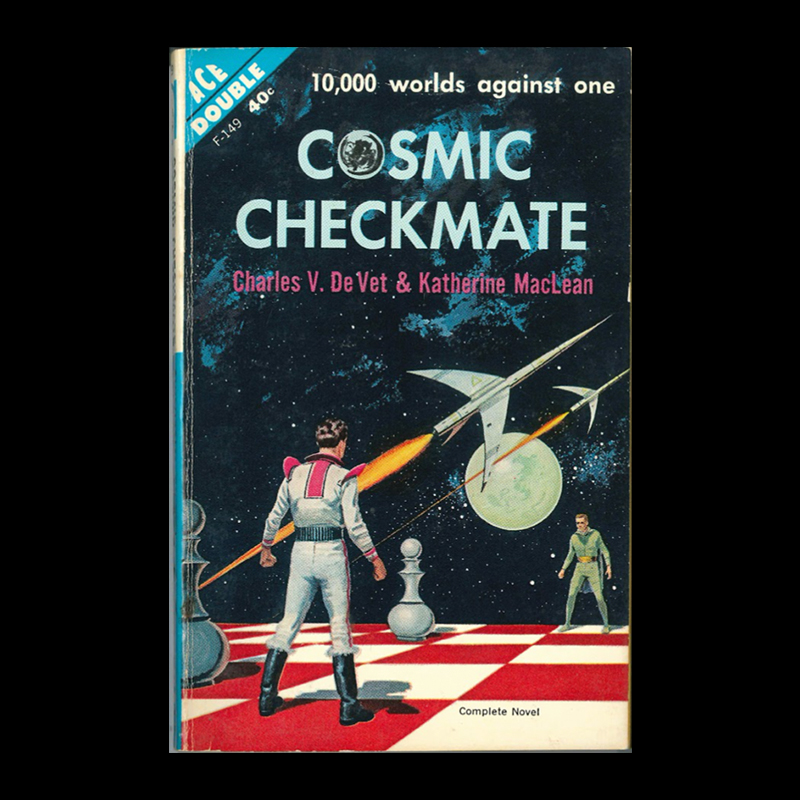
Charles V. De Vet and Katherine MacLean
Cosmic Checkmate
1962
6 ⁵⁄₁₆ x 4 ¹⁄₁₆ in.
Book
Collection of the World Chess Hall of Fame
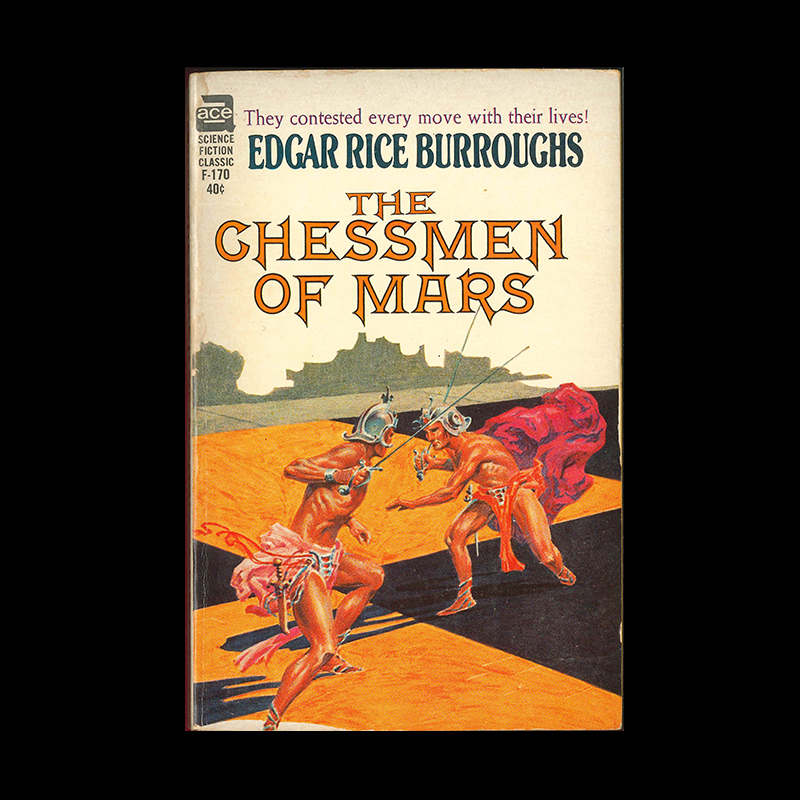
Edgar Rice Burroughs
The Chessmen of Mars
1922
6 ¹⁄₂ x 4 ¹⁄₂ in.
Book
Collection of The World Chess Hall of Fame
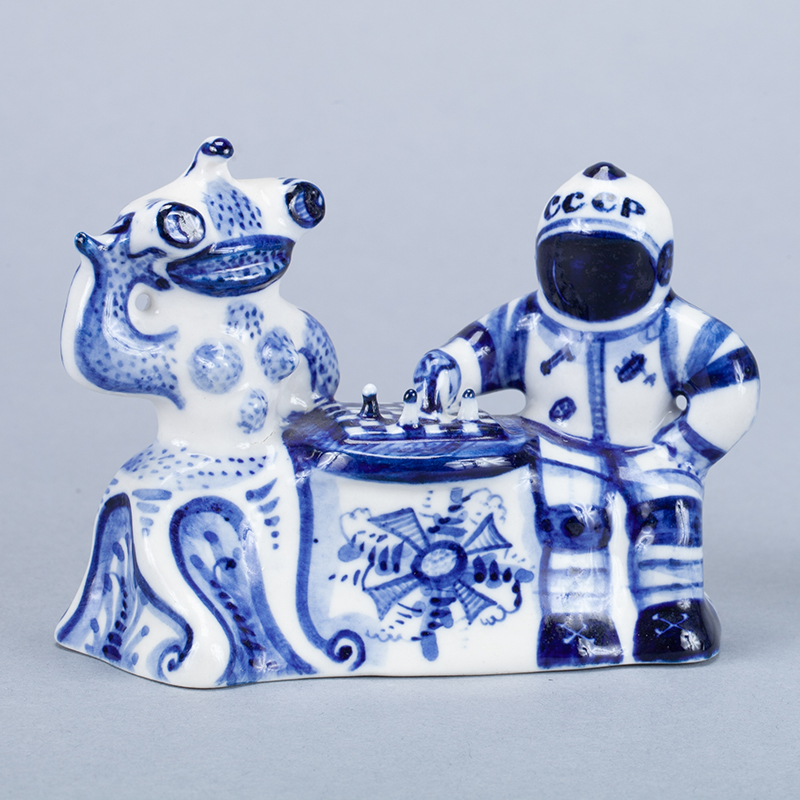
Yuri Garanin for Gzhel
Humans vs. Alien Chess Match
Date unknown
3 x 4 x 2 in.
Porcelain
Collection of the World Chess Hall of Fame
The First Public Earth vs. Space Chess Match
Of all imaginable things that could have happened during my time in space, I had no idea that a chess match would be the most historic. Officially, in the battle of the first ever public Earth vs. Space chess match, the winner was Earth, but this is not the whole story. In fact, this was not the first game. Even more, the winner may or may not be Earth! How could this be? Well, the unofficial story is a little more intriguing and a lot more amusing.
Prior to my own first mission, I was a CapCom in NASA’s Mission Control, the voice speaking to the crew onboard the International Space Station (ISS). I was curious about the informal games that I saw several crews ‘play’ with those of us on the ground. The purpose was to boost morale for the team and to have some sort of engagement beyond the daily grind of executing procedures and solving problems. Of course, being involved in a spaceflight mission is, and was, exciting stuff! But as with anything else, the tasks of the day, in and of themselves, were simply that—tasks. They created little opportunity for rapport between the crew and ground. At some point, the games began, and they were typically simple and silly things, like guessing games and trivial pursuits. I distinctly recall sitting on-console in Mission Control thinking, “when I fly, it’s going to be a real game, a serious game…a chess game!”
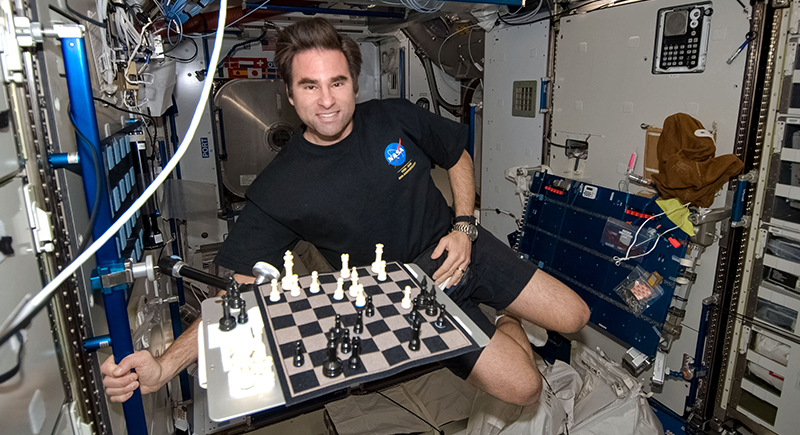
Photographer Unknown
Greg Chamitoff Plays Chess in the Harmony Node of the International Space Station during Expedition 17
July 19, 2008
Courtesy of the National Aeronautics and Space Administration
As my turn to fly on ISS Expedition 17 approached, I began shopping for a chess set that I could adapt for zero gravity. I found the perfect set—a plastic-coated metallic board with magnetic pieces. I was in business. That is, until NASA saw this strange personal item on my manifest list with magnets. “No magnets allowed,” they said. “It could interfere with electronic devices onboard.” This was just a few weeks before launch, and I panicked. Quarantine was a week away, it was BUSY, and there was little time to purchase and receive something else. My solution, of course, was Velcro! I bought a cheap set of plastic pieces and packaged them with Velcro sheets. One of my first and most important tasks in space was to cut out circular pieces of sticky-back Velcro and attach them to the bottom of 32 chess pieces. It worked! I had a Zero-G chess set and was ready to challenge Mission Control to a game.
As part of an International Space Station program, the first Earth vs. Space chess game was naturally going to be a round-the-world engagement with all the primary mission control centers involved—Houston, Huntsville, Moscow, Montreal, Oberpfaffenhofen (Germany), Tsukuba (Japan), and Toulouse. The arrangement was that each control center would make a move in turn without kibitzing between control centers. Little did I know that NASA organized a small tiger team of enthusiastic chess players to assure that NASA won. The first game didn’t go well—for Earth, that is!
Taking turns between countries to move ended up being a serious handicap. So much so that I later heard that Moscow was politely furious with Japan for losing the game. They demanded a Russian-only rematch, which resulted in multiple ongoing simultaneous games with each country. Playing one game was easy enough, but six simultaneous games was a stretch. After all, the mission planners didn’t allocate time in the schedule for chess!
Before these games could finish, however, a few special folks on planet Earth invented a bigger bolder version of Earth vs. Space Chess, that would engage the public at large. Along with the US Chess Federation (US Chess) and the NASA Public Affairs Office (PAO), they created a public game where anyone on Earth could vote for their favorite moves. A team of exceptional chess experts was selected to advise. They were the 3rd grade national chess champions from Stevenson Elementary School in Bellevue, Washington. After each move from space, the students would analyze the game, pick a handful of top moves, and post them online for public voting. This game did go well!
It was a very exciting game, with many twists and turns, but ultimately Earth was victorious. There is a deeper meaning to this victory. If the 3rd grade team beat me, and I beat Mission Control, then the inescapable conclusion is that the 3rd grade team is smarter than Mission Control! Right?
This was all so fun and inspiring that we did it again three years later during the last mission of Space Shuttle Endeav-our (STS-134) (May 16-June 1, 2011). It was a fast-paced game with space represented by Box and Taz (my crewmate Gregory Johnson and myself). Being a much shorter mission, the game was completed on the ground on September 10, 2011, during the inaugural ceremony of the Boy Scouts of America chess merit badge, which was spearheaded by Dr. Jeanne Sinquefield. With grandmasters leading the charge, scouts acted out the game on a life-size board in the streets of Saint Louis. Trailing by a pawn that was sacrificed for an upper hand on the offensive that Box and I maintained for much of the game, Earth vs. Space ultimately came to a stalemate. It seems that another rematch is in order during a future mission. Perhaps next time space will be represented by a female moon-walking Eagle Scout!
By the way, ISS Expedition 17 and Space Shuttle STS-134 were spectacular missions that helped pave the way for future exploration of our solar system. For more information see (https://www. nasa.gov/content/human-missions-list). Special thanks to Hal Bogner (US Chess Federation) and Kelly Humphries (NASA Public Affairs Office) for making this all possible, and to the Saint Louis Chess Club, World Chess Hall of Fame, and Boy Scouts of America for their roles in the Earth vs. Space chess competition.
—Greg Chamitoff, Ph.D., Former NASA Astronaut
Dr. Gregory Chamitoff served as a NASA Astronaut for 15 years, including Shuttle Missions STS-124,126,134 and Space Station long duration missions Expedition 17 and 18. He has lived and worked in space for almost 200 days as a Flight Engineer, Science Officer, and Mission Specialist. His last mission was on the final flight of Space Shuttle Endeavour, during which he performed two spacewalks, including the last one of the Shuttle era, which also completed the assembly of the International Space Station. Chamitoff also played the first public Earth vs. Space chess game. He earned his B.S. in Electrical Engineering from Cal Poly, M.S. in Aeronautics from Caltech, and Ph.D. in Aeronautics and Astronautics from MIT. Chamitoff also holds a Minor and a Masters in Planetary Science. He is currently a Professor of Practice in Aerospace Engineering, and Director of the AeroSpace Technology Research & Operations (ASTRO) Laboratory at Texas A&M University. Chamitoff is co-author and co-editor of Human Spaceflight Operations, a textbook on the lessons learned from the past 60 years of spaceflight. His research includes space robotics, autonomous systems, and the development of collaborative VR simulation environments for space system engineering and mission design.
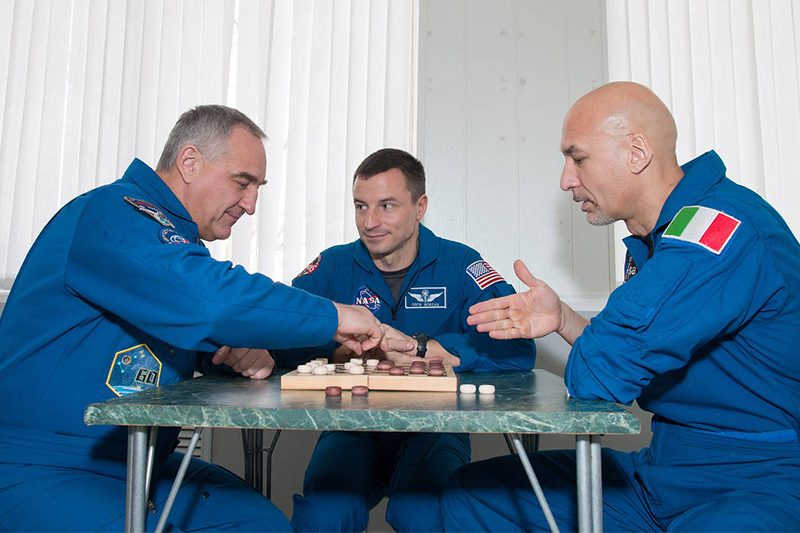
Victor Zelentsov
Expedition 59 Crew Members Nick Hague,
Christina Koch, and Alexey Ovchinin Take
a Moment for a Game of Chess
March 7, 2019
11 x 14 in.
Photograph
Courtesy of the National Aeronautics
and Space Administration
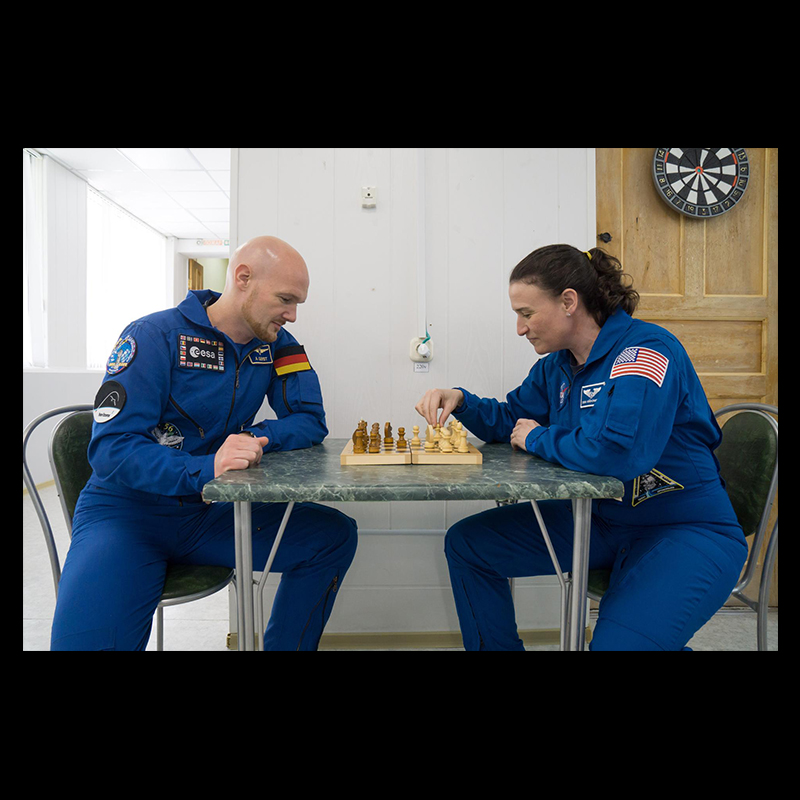
Victor Zelentsov
Expedition 56 Crew Members Alexander Gerst and Serena Aunon-Chancellor Try Their Hand at a Game of Chess
May 29, 2018
Dims
Photograph
Courtesy of the National Aeronautics and Space Administration
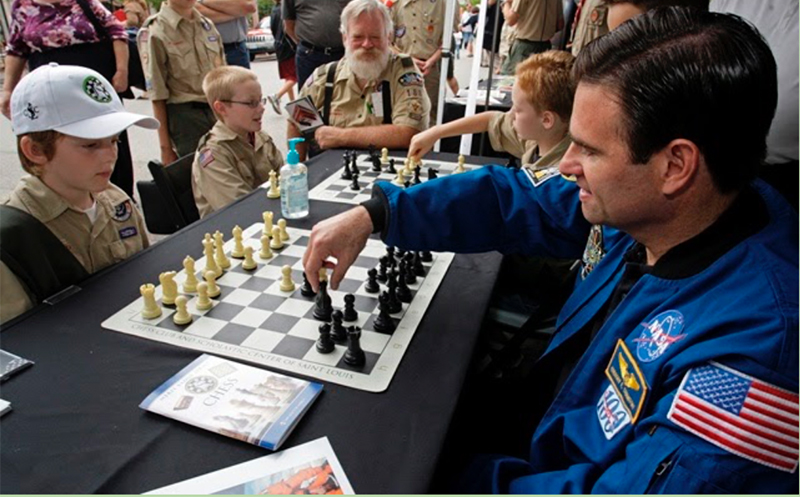
Lori Matler
Astronaut Gregory E. Chamitoff Plays Chess
with a Boy Scout Earning his Chess Merit Badge
September 10, 2011
11 x 14 in.
Photograph
Collection of the World Chess Hall of Fame
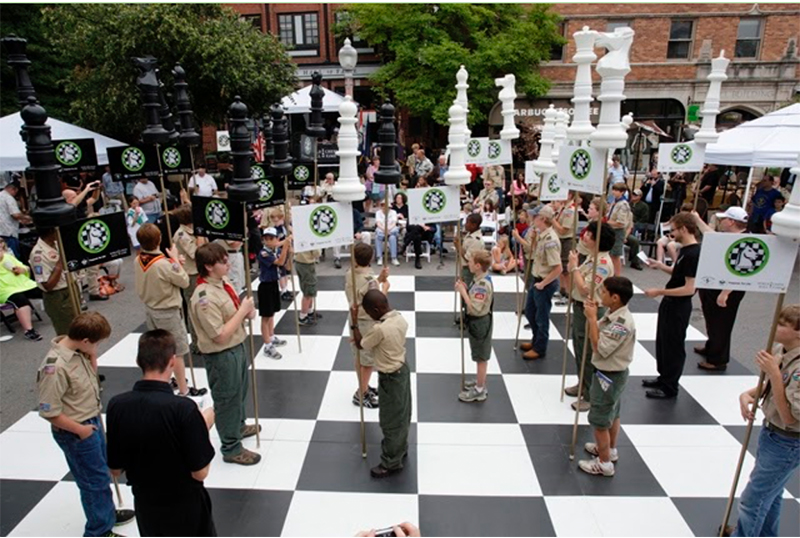
Lori Matler
Scouts BSA Reenactment of the First
Earth vs. Space Chess Match
September 10, 2011
8 x 10 in.
Photograph
Collection of the World Chess Hall of Fame
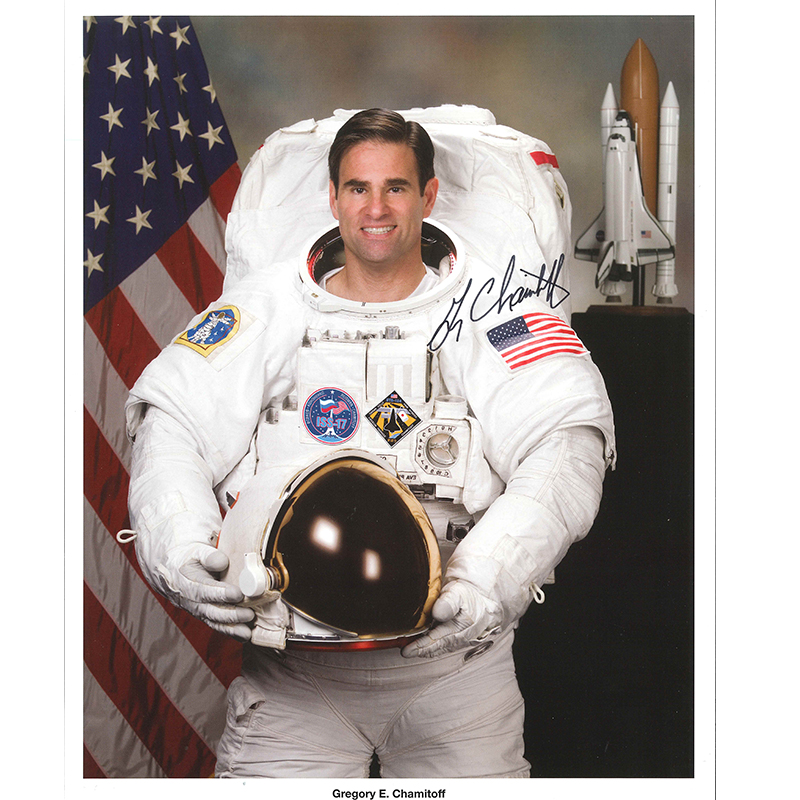
Photographer unknown
Signed Photo of Astronaut Gregory E. Chamitoff
2008
10 x 8 in.
Photograph
Collection of the World Chess Hall of Fame
Source: worldchesshof.org















